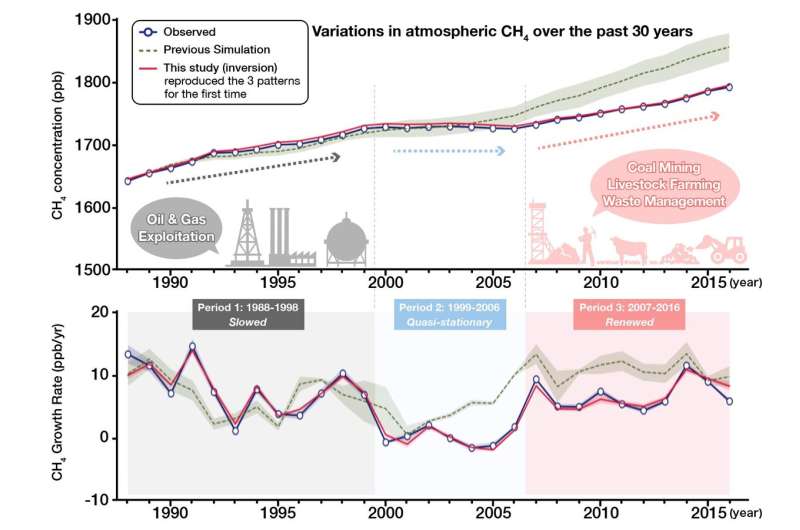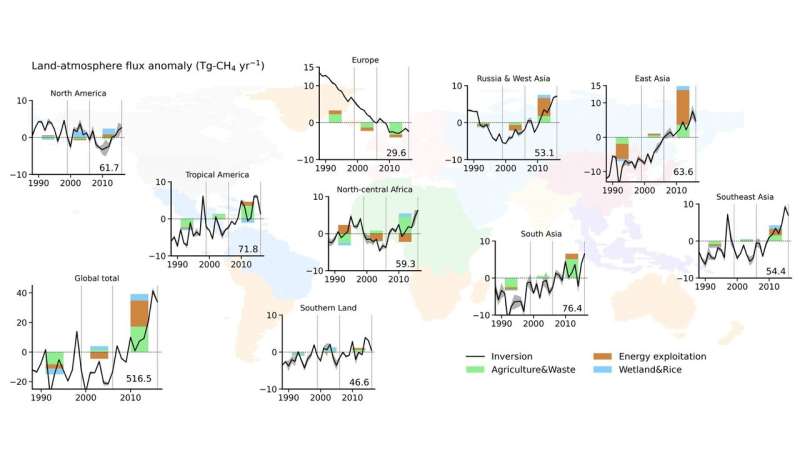Human activity caused the long-term growth of greenhouse gas methane

Methane (CH4) is the second most important greenhouse gas after carbon dioxide (CO2). Its concentration in the atmosphere has increased more than twice since the preindustrial era due to enhanced emissions from human activities. While the global warming potential of CH4 is 86 times as large as that of CO2 over 20 years, it remains in the atmosphere for about 10 years, a much briefer span than CO2, which can remain in the atmosphere for centuries. It is therefore expected that emission control of CH4 could have beneficial effects over a relatively short time period and contribute quickly to the Paris Agreement target to limit the global warming well below 2 degrees.
A study by an international team, published in Journal of Meteorological Society of Japan, provides a robust set of explanations about the processes and emission sectors that led to the hitherto unexplained behaviors of CH4 in the atmosphere. The growth rate (annual increase) of CH4 in the atmosphere varied dramatically over the past 30 years with three distinct phases: the slowed (1988-1998), quasi-stationary (1999-2006) and renewed (2007-2016) growth periods (Fig. 1). However, there is no scientific consensus on the causes of CH4 growth rate variability. The team, led by Naveen Chandra of National Institute for Environmental Studies, combined analyses of emission inventories, inverse modeling with an atmospheric chemistry-transport model, and global surface/aircraft/satellite observations to address this problem.
They show that reductions in emissions from Europe and Russia since 1988, particularly from oil and gas exploitation and enteric fermentation, led to the slowed CH4 growth rates in the 1990s (Fig. 2); reduced emissions from natural wetlands due the effects of the Mount Pinatubo eruption and frequent El Niño events also played roles. This period was followed by the quasi-stationary state of CH4 growth in the early 2000s. CH4 rose again from 2007, which was attributed to increases in emissions from coal mining, mainly in China, and intensification of livestock (ruminant) farming and waste management in tropical South America, north-central Africa and south and southeast Asia. While the emission increase from coal mining in China has stalled in the post-2010 period, the emissions from the oil and gas sector in North America has increased (Fig. 2). There is no evidence of emission enhancement due to climate warming, including in the boreal regions, during the analysis period.
These findings highlight key sectors (energy, livestock and waste) for effective emission reduction strategies toward climate change mitigation. Tracking the location and source type is critically important for developing mitigation strategies and the implementation of the Paris Agreement. The study also emphasizes the need for more atmospheric observations with space and time densities greater than existing analyses.

More information: Naveen CHANDRA et al, Emissions from the Oil and Gas Sectors, Coal Mining and Ruminant Farming Drive Methane Growth over the Past Three Decades, Journal of the Meteorological Society of Japan. Ser. II (2020). DOI: 10.2151/jmsj.2021-015
Provided by National Institute for Environmental Studies





















